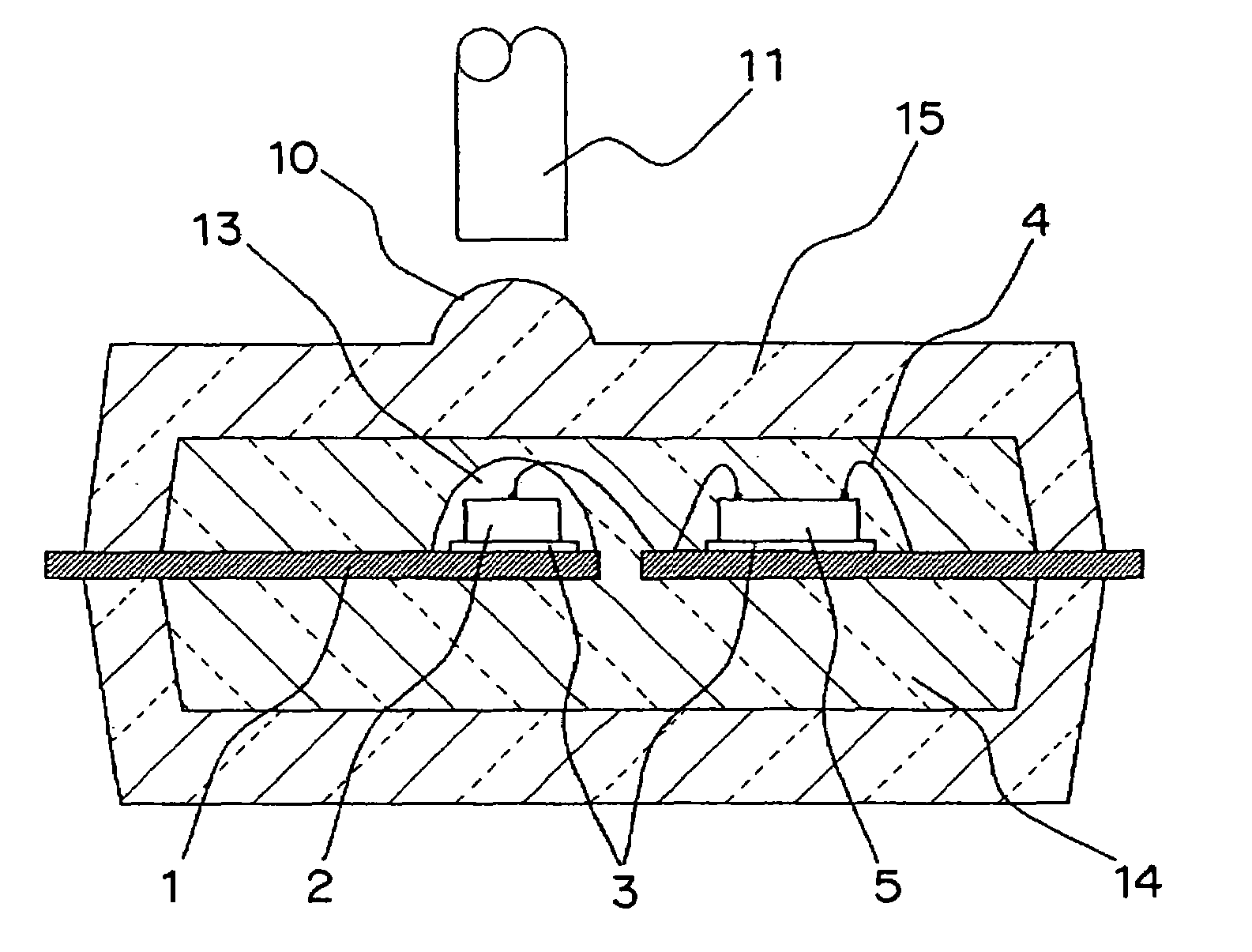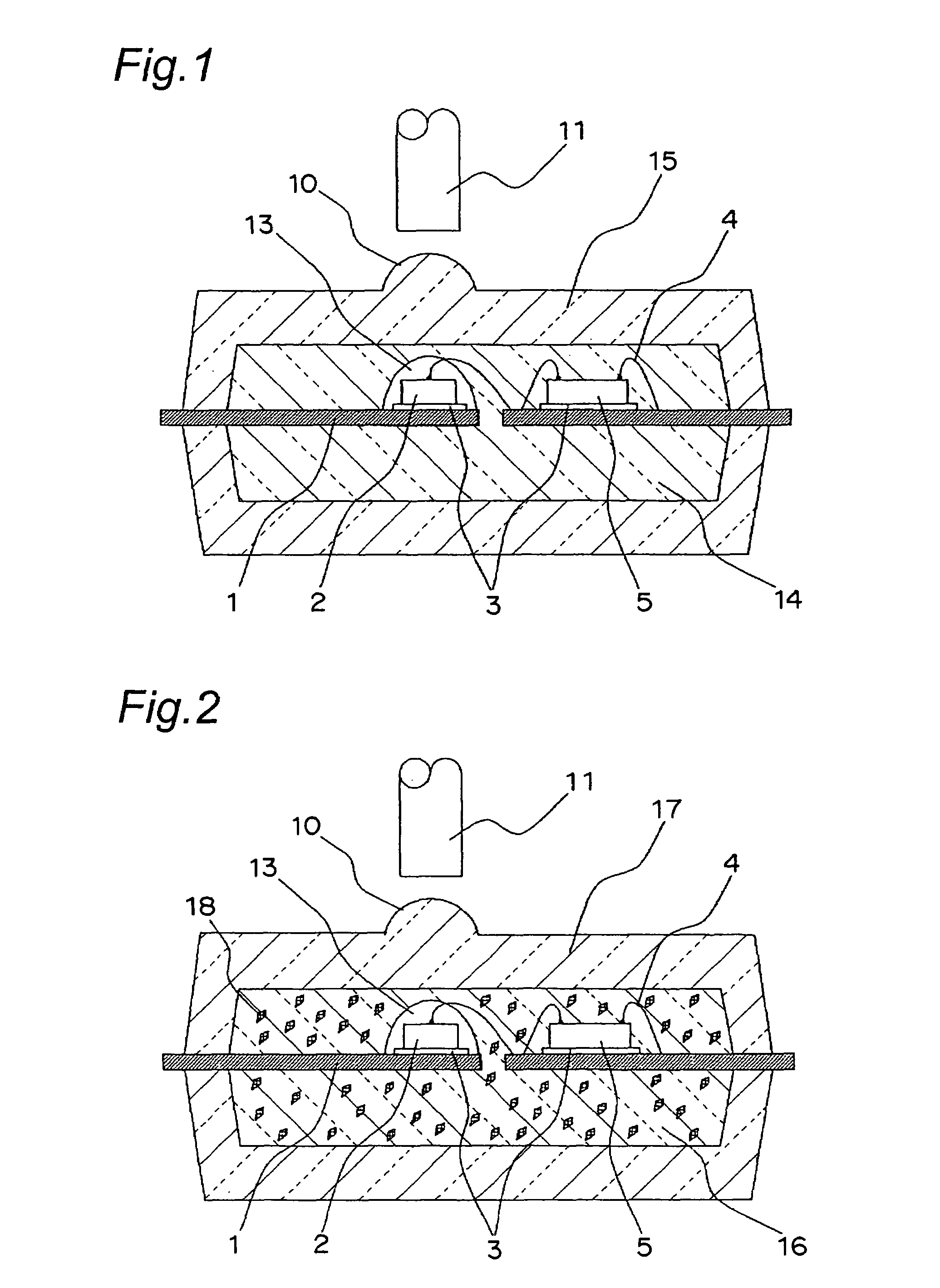Optical semiconductor device, method for fabricating the same, lead frame and electronic equipment
a technology of optical semiconductor and semiconductor device, applied in semiconductor devices, semiconductor/solid-state device details, electrical equipment, etc., can solve problems such as heat dissipation, package cracking, and thermal shock resistance, and achieve satisfactory optical transmission quality and high reliability
- Summary
- Abstract
- Description
- Claims
- Application Information
AI Technical Summary
Benefits of technology
Problems solved by technology
Method used
Image
Examples
ninth embodiment
[0215]FIG. 6 is a schematic structural view of the optical semiconductor device of the ninth embodiment of the present invention. The optical semiconductor device of the ninth embodiment of the present invention has the same construction as that of the sixth embodiment except for the first mold resin portion, and like components are denoted by like reference numerals with no description provided therefor.
[0216]In the optical semiconductor device of the ninth embodiment, as shown in FIG. 6, an acid anhydride curing epoxy resin filled with transparent filler 18′ is used for the second mold resin portion 19. The loading weight of filler with which the second mold resin portion 19 is filled is set to 75% or less than that of the filler with which the first mold resin portion 21 is filled.
[0217]According to the optical semiconductor device of the ninth embodiment, an optical semiconductor device, which is able to reduce the difference in the coefficient of linear expansion between the fi...
tenth embodiment
[0218]FIG. 7 is a schematic structural view of the optical semiconductor device of the tenth embodiment of the present invention. The optical semiconductor device of the tenth embodiment of the present invention has the same construction as that of the ninth embodiment except for the second mold resin portion, and like components are denoted by like reference numerals with no description provided therefor.
[0219]In the optical semiconductor device of the tenth embodiment, as shown in FIG. 6, a phenolic curing epoxy resin, of which the loading weight of the transparent filler 18′ is smaller than that of the first mold resin portion 21, is used for the second mold resin portion 20.
[0220]According to the optical semiconductor device of the tenth embodiment, the difference in the coefficient of linear expansion between the first mold resin portion 21 and the second mold resin portion 20 is reduced, and the occurrence of resin interface separation due to thermal stresses can be reduced by...
eleventh embodiment
[0221]Next, the optical semiconductor device of the eleventh embodiment of the present invention has the same construction as that of the optical semiconductor device of the fifth embodiment except for the first mold resin portion and should correspondingly be referred to FIG. 2.
[0222]In the optical semiconductor device of the eleventh embodiment, the loading weight of the transparent filler with which the first mold resin portion 16 is filled is controlled within a range of 20 to 80 percent by weight.
[0223]According to the optical semiconductor device of the eleventh embodiment, an optical semiconductor device, which is able to reduce the coefficient of linear expansion α1 of the first mold resin portion 16, increase the thermal conductivity with a high transmissivity maintained and has a satisfactory optical transmission quality and a high reliability, can be fabricated compactly at low cost.
[0224]The condition of the loading weight of the transparent filler of the optical semicon...
PUM
 Login to View More
Login to View More Abstract
Description
Claims
Application Information
 Login to View More
Login to View More - R&D
- Intellectual Property
- Life Sciences
- Materials
- Tech Scout
- Unparalleled Data Quality
- Higher Quality Content
- 60% Fewer Hallucinations
Browse by: Latest US Patents, China's latest patents, Technical Efficacy Thesaurus, Application Domain, Technology Topic, Popular Technical Reports.
© 2025 PatSnap. All rights reserved.Legal|Privacy policy|Modern Slavery Act Transparency Statement|Sitemap|About US| Contact US: help@patsnap.com



